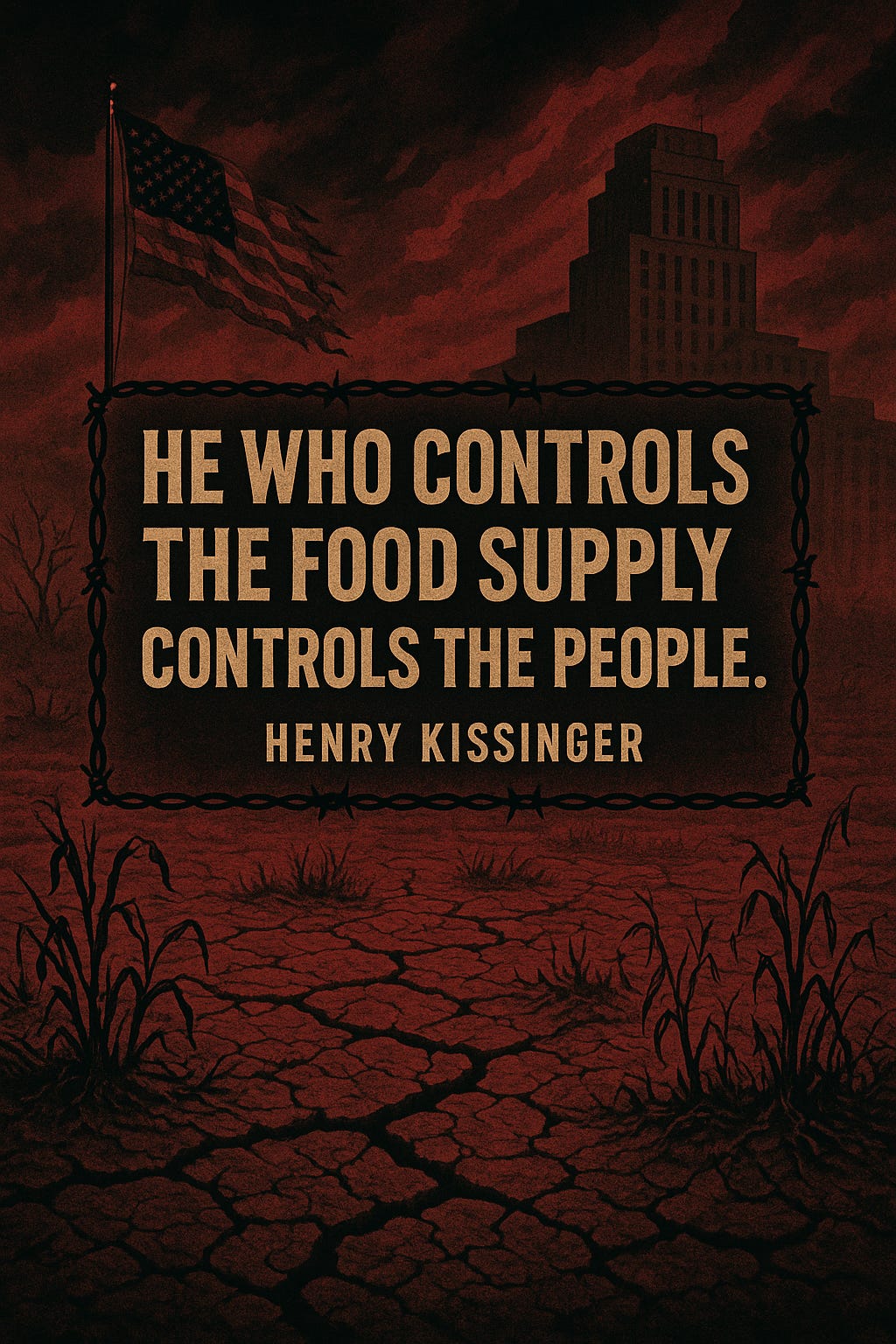Farming on a Leash: Can Idaho Survive Without D.C. Dollars?
When the Check Stops Coming: Is Idaho Agriculture Ready to Stand Alone?
Can Idaho Agriculture Stand on Its Own—Without Federal Grants and Subsidies?
Two legislative sessions ago, I published a Substack that dug deep into government subsidies, specifically highlighting how deeply intertwined federal dollars have become with Idaho agriculture. I even included a screenshot listing some of the farmers who had received substantial funds. That post sparked quite a reaction.
Shortly after, I was removed from my role as Vice Chair of the Health and Welfare Committee. At the time, I didn’t fully understand why. But I later learned that sharing those names—despite being public information—ruffled feathers in the wrong circles. In an effort to mend relationships and keep the peace within the legislature, I took the post down. I regret that decision. Hindsight may not be 20/20 in politics, but it certainly brings clarity. I should have stood my ground.
Recently, I came across an article that reignited this issue: “USDA Terminates University of Idaho Grant to Help Farmers.”(UIdaho) That headline hit hard—not because it’s unexpected, but because it’s a warning shot. The federal rug can and will be pulled out from underneath us, and we need to ask ourselves the hard question: Can Idaho agriculture survive without the federal government propping it up?
That question isn't rhetorical. It deserves serious discussion, not just among lawmakers, but among farmers, ranchers, and Idaho families who depend on the land for their livelihood and legacy.
I’ve resumed my research. And the more I uncover, the more urgent this becomes. We’ve got to start having honest conversations about independence, sustainability, and what it will take for Idaho to feed itself—and maybe even thrive—without strings attached from D.C.
Because here’s the truth: federal money always comes with strings. And the more dependent we become, the more vulnerable we are when those strings are cut—or yanked.
Let’s talk about it.
I began by researching how many different federal grant programs are currently in use in Idaho—and found that over 44 separate grants have been applied for across the state. They fall in these 7 different categories, links provided for you to do your own research.
Federal Programs Administered in Idaho
1. Conservation Reserve Program (CRP)
Purpose: Provides annual rental payments and cost-share assistance to farmers who remove environmentally sensitive land from agricultural production and plant species that improve environmental health.
Impact in Idaho: From 1995 to 2023, Idaho farmers received over $910 million through CRP, making it the state's largest conservation subsidy.
Administered by: USDA Farm Service Agency (FSA).
More Info: FSA Idaho Programs
2. Environmental Quality Incentives Program (EQIP)
Purpose: Offers financial and technical assistance to agricultural producers to plan and implement conservation practices that improve soil, water, plant, animal, air, and related natural resources.
Administered by: USDA Natural Resources Conservation Service (NRCS).
More Info: EQIP Idaho
3. Conservation Stewardship Program (CSP)
Purpose: Encourages producers to maintain and improve existing conservation systems and adopt additional conservation activities.
Administered by: USDA NRCS.
More Info: NRCS Programs
4. Value-Added Producer Grants (VAPG)
Purpose: Helps agricultural producers enter value-added activities to generate new products, create and expand marketing opportunities, and increase producer income.
Administered by: USDA Rural Development.
More Info: VAPG Programs
5. Specialty Crop Block Grant Program (SCBGP)
Purpose: Enhances the competitiveness of specialty crops (fruits, vegetables, tree nuts, etc.) through projects in marketing, education, pest and disease control, and more.
Administered by: Idaho State Department of Agriculture (ISDA).
More Info: SCBGP IdahoSCBGP Idaho
6. Sustainable Agriculture Research and Education (SARE) Grants
Purpose: Supports research and education projects that advance sustainable innovations to the whole of American agriculture.
Impact in Idaho: Since 1988, Idaho has received over $7.8 million supporting 92 projects.
More Info: SARE Idaho Projects
7. Emergency Commodity Assistance Program (ECAP)
Purpose: Provides financial assistance to producers facing losses due to natural disasters or low commodity prices.
Recent Development: In March 2025, USDA began disbursing $10 billion in aid to farmers amid low prices.
More Info: USDA Idaho
Farm Subsidies or Federal Favors? Who’s Really Reaping the Harvest?
Since 1995, Idaho has received over $5.45 billion in federal farm subsidies. That sounds impressive—until you realize that only 24% of Idaho farms have seen a single dime. In plain terms, three out of four Idaho farms have been left behind, while bureaucrats and programs with flashy titles soak up taxpayer dollars under the banner of “climate solutions.”
A prime example? The Partnerships for Climate-Smart Commodities program. More than 200 Idaho producers applied in good faith. It was shaping up to be the largest agricultural grant in the University of Idaho’s history. Then, without warning, USDA pulled the plug in April 2025.
Why? Secretary Rollins didn’t mince words:
“The Partnerships for Climate-Smart Commodities initiative was largely built to advance the Green New Scam at the benefit of NGOs, not American farmers… These partnerships were bloated with red tape, vague objectives, and complex reporting requirements that pushed actual producers out of the picture.” (Rollins)
This isn’t just a one-off misfire. It reflects a deeper, more troubling trend.
The majority of federal farm subsidies in Idaho don’t go to the small, family-run operations that form the backbone of our communities. They go to large corporate farms and industrial-scale operations. Nationwide, the top 10% of subsidy recipients raked in more than 79% of total subsidies between 1995 and 2021.
Here in Idaho, the Environmental Working Group reports that the top subsidy recipient pulled in over $11 million between 1995 and 2023. These big players have the legal teams and administrative muscle to navigate complicated federal programs. Meanwhile, smaller farms often don’t have the capacity or time to fight through the red tape. Many simply give up before they begin. Who are some of these recipients? (Click Here)
That’s not a system built on fairness or food security. It’s a system built on power and access.
So it’s time to ask the hard questions:
Who’s really benefiting from these programs?
Who’s writing the rules—and who’s getting written out?
Dwight D. Eisenhower
"Farming looks mighty easy when your plow is a pencil, and you're a thousand miles from the corn field."
Don’t just follow the money. Follow the power. Ask why Idaho’s small and mid-sized farms—the ones feeding your family and stewarding your land—are left to fight for scraps, while out-of-state nonprofits and corporate giants cash in.
Because if we don’t speak up now, we may wake up in an Idaho where the family farm is just a memory—and federal favors have replaced local food.
If government controls access to food and water, it can reward compliance and punish dissent. It’s no longer just about enforcing laws—it’s about controlling behavior. History shows us that regimes have withheld food from political opponents or used it to enforce ideological conformity. When your next meal depends on government approval, liberty becomes negotiable.
“He who controls the food supply controls the people.” – Henry Kissinger (widely attributed)
I don’t share this to stir fear—I share it to ignite awareness. To call us to vigilance, not panic. I’m not against agriculture—I’m its fiercest advocate. I believe in the hands that till our soil, raise our herds, and steward our land with grit and grace.
While many are worried about how we’ll feed the world, maybe it's time we ask how we’ll feed our own state. Idaho must protect its food supply, its water rights, and its farmers—not hand them over to unelected agencies or global agendas.
Let’s be informed. Let’s be engaged. And above all, let’s be ready. Because if we don’t stand for our farmers now, we may not have any left to stand for.
I hope you can join us:
Save the Date:
Proverbs 12:11 (ESV)
"Whoever works his land will have plenty of bread, but he who follows worthless pursuits lacks sense."Quote of the Week:
Thomas Jefferson
"Agriculture is our wisest pursuit, because it will in the end contribute most to real wealth, good morals, and happiness.








THANK YOU for this, Glenneda. One of the points that keeps hitting home throughout your piece is that the smaller farms and ranches don't even receive most of these subsidies. This reflects the government/corporate cronyism that goes on in so many other areas of our life, not just agriculture. One wonders if giving so much clout to corporate farming may have actually harmed our industry!
That said, another thing that stuck out like a sore thumb to me is that only one of these seven programs is administered through the ISDA. Under Pat Takasugi's leadership, ISDA was a model that other states envied. He hired top people in every division, trusted his people to do their work, had them involved in national committees and agencies giving Idaho a seat at the table and a heads-up on what was going on, and truly supported every aspect of Idaho agriculture. Now, two short decades later, while we still have a somewhat robust Animal Industries Division, the Plant Industries Division, the Agricultural Resources, and some of the other subdivisions are struggling. Much of the expertise and experience level with the industry is sorely lacking. The once-productive relationship with our Land Grant college (U of I) has all but been severed. Increasingly, control of our industry within our state has been ceded to these very same federal programs which are now being threatened. This is an issue which has been largely ignored by our state legislature and its House and Senate Agricultural Affairs Committees.
Because of that, Idaho is not in a very good position to weather the inevitable federal shuffle--and agriculture is the #1 industry in our state. Alongside our fiscal bloat as a state, this is one of the primary reasons why I put my hat in the ring to run for a House seat in my district!
I love this article. FINALLY SOMEONE IS EXPOSING THE TRUTH. Yet my concern is the use of subsidies. Subsidies is another term for welfare. The farmers and ranchers have been on welfare for years, receiving federal and state tax dollars to stay alive, including the minimal fees charged for exploiting public lands in grazing fees, leases and allotments. A lot of corporate owned ranches and farms use this welfare to extract higher profits and drive out the small farms and ranches.
No one is watching what is going on. To make room for the exploitation and sell-off of public lands, water rights are being stolen, wild horses and burros are being slaughtered for food and products, and the wildlife obliterated through non stop hunting, trapping and further exploitation. This isn't a comment from a bleeding heart liberal. This is a wake up call to the permanent loss we as Idahoans are facing that will change out state forever and can't return.